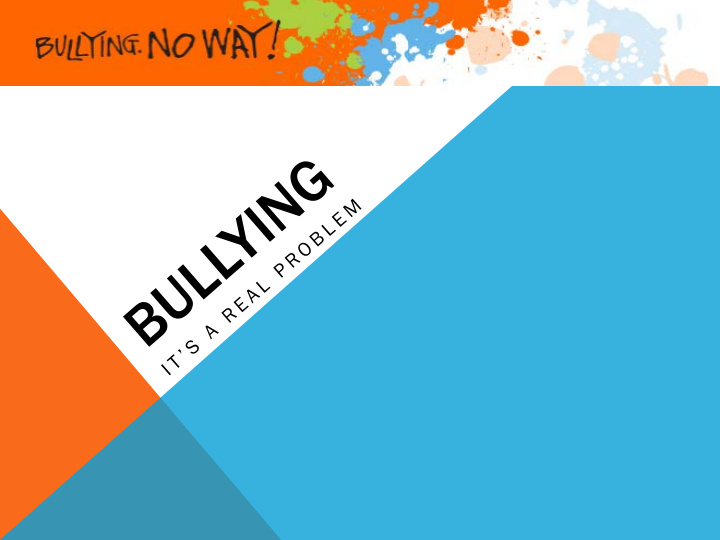



WHY THE FOCUS ON BULLYING? School wide f focus and nd stance on n una unacceptable behaviour. • Current r Cur review a and nd development o of po policy a and nd pr procedure aroun und Bul ullying. • - to o do o this we need a a clear and c con onsistent d definition of of what i is d deemed b bullying. - Inc ncrease c conf nfidence of everyone to talk a aroun und what i is a and nd isn’t bul ullying.
WHAT DO YOU BELIEVE BULLYING TO BE? Inconsistency in definition leads to confusion and misconceptions between staff, students and parents.
THE HARMFUL EFFECTS OF MISLABELLING BULLYING The negative connotations around bullying • • Emotional- Children's sense of self being effected when called a bully. • Cognitive bias- The labels of 'bully' or 'victim' can also cause further harm if a child accepts them as part of their social identity. • Unnecessary fear- Mislabelling bullying induces fear in children from both parties. Children being frightened they may be bullied at any time and children scared actions will be misinterpreted as bullying. Unnecessary fear defeats trying to create resilient children.
DEFIN FINITIO ION O OF F BULL LLYIN ING The national definition of bullying for Australian schools says: Bullying is an ongoing misuse of power in relationships through repeated verbal, • physical and/or social behaviour that causes physical and/or psychological harm. It can involve an individual or a group misusing their power over one or more persons. Bullying can happen in person or online, and it can be obvious (overt) or hidden (covert). Bullying of any form or for any reason can have long-term effects on those • involved, including bystanders. Single incidents and conflict or fights between equals, whether in person or • online, are not defined as bullying.
EXPLORIN ING T THE HE DEFIN FINIT ITION FU FURTHE HER Bullying has three main features: It involves a misuse of power in a relationship • It is ongoing and repeated, and • It involves behaviours that can cause harm. •
WHAT IS NOT BULLYING? Behaviours that do not constitute bullying include: mutual arguments and disagreements (where there is no power • imbalance) not liking someone or a single act of social rejection • one-off acts of meanness or spite • isolated incidents of aggression, intimidation or violence •
WHAT IS BULLYING https: s://bullyingnoway.gov.au/resources/videos/pa pages/videopl player.aspx px?VideoID=82 D=82
TYPE O OF BEHAVI VIOU OUR – VERBAL, PH PHYSICAL AN AND D SOC SOCIAL There are three types of bullying behaviour: Ver erbal bal bu bullying which includes name calling or insulting someone about physical characteristics such as their weight or height, or other attributes including race, sexuality, culture, or religion Phys ysical b bullyi ying which includes hitting or otherwise hurting someone, shoving or intimidating another person, or damaging or stealing their belongings So Social al bu bullying which includes consistently excluding another person or sharing information or images that will have a harmful effect on the other person.
ONGOING AND REPEATED https: s://bullyi yingnoway.go gov.a .au/res esources es/videos/pages es/videoplayer er.aspx?Video eoID=10 2
HOW TO HELP CHILDREN BEING BULLIED Define B Bully lying – use e situations t to do t this Wo Word rds to av avoid Avoid describing a child as a 'bully' or a 'victim'. Although these words are often used in research and in the media, they are not very helpful for finding positive and lasting solutions. Talk lk abou bout b bully lying w with t the u understan anding t that c child ldren a and young p peop ople le a are g growing a and s still l lea learning h how t to be ef e effective mem embers o of the e community. When you talk about bullying, focus on more appropriate ways to act with others and positive ways to get on with other people. If the behaviour is not bullying and you are stuck for how to describe it use the terms targeted/unacceptable behaviour. Talk around schools stance on unacceptable behaviour. Children can change the way they behave with support from parents and teachers. If the labels of 'bully' or 'victim' stick, it can make it harder for them to change. Using these words can suggest that bullying and being bullied are due to unchangeable things about the children involved.
WHAT IS THE SCHOOL DOING ABOUT BULLYING • Stymie- Making a notification • Policy/procedures • Social emotional wellbeing/positive education
RESOURCES https://bul ullying ngno noway.gov.au/
RESOURCES https://ww www.es esafet ety.g .gov.a .au/
QUESTIONS
Recommend
More recommend